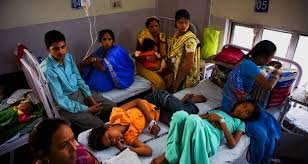7 Major Problems of Health Services in India
After Independence there has been a significant improvement in other sector like technology, defence, education but the health care service in India is not up to the mark as per WHO report.
India ranks 145th among 195 countries in terms of quality and accessibility of healthcare, behind its neighbours like China, Bangladesh, Sri Lanka and Bhutan, according to a Lancet study.
Even Bangladesh is ahead of India. Isn't it matter of shame ??
India lags behind China (48), Sri Lanka (71), Bangladesh ( 133) and Bhutan (134) while its health index was better than Nepal (149), Pakistan (154) and Afghanistan (191).
The five small countries with the highest levels of healthcare access and quality in 2016 were Iceland with 97.1 points, Norway with 96.6, the Netherlands with 96.1, Luxembourg with 96.0, and Finland with 95.9 and Australia with 95.9 as well.
The following are the major problems of health service of India.

- Neglect of Rural Area:
India’s health service is much better in Urban area while it neglect rural masses. It make more emphasis on urban hospitals. Although, there are large no. of small public hospitals in rural area but development in urban area and it's bias is visible. According to health survey, for 75% of total population ( Rural area ) there are only 31.5% of hospitals and 16% hospital beds are situated.
Major reason behind this large gap is, doctors are unwilling to serve in rural areas. Specially
young doctors are mostly trained in medically sophisticated, highly urban, tertiary care institutions. Both in terms of acquired skills and cultural affinity, they are alienated from the rural environment and feel ill-equipped to deal with the health challenges and resource constrained environment of basic health care facilities. Indian government need to develop district hospitals as major training centres for medical and nursing students, with both downstream exposure to primary health systems and upstream exposure to tertiary care.
- Emphasis on Culture Method:
The healthcare system of India is almost borrowed from western countries. It has no roots in the culture and tradition of the people. It's service is based on urban hospitals. This has been at the cost of providing comprehensive primary health care to all. Otherwise speaking, it has completely neglected preventive, pro-motive, rehabilitative and public health measures like in Cuba. "Prevention is better than cure" is Philosophy of cuban health care sector, where thousands of health care proffesionals walk everyday to take care of masses. Unlike in India where patients walk to hospital to get cure. And it became tradition in rural area that if you are not feeling well then you need to go to nearby city for better treatment.
- Inadequate Outlay for Health:
Indian health care service is largely depend on pocket money of public instead of government fund. According to survey of National Health Policy, the government contribution for health service constitutes only 0.9 % of it's GDP which is quite insufficient for second largest population. In India, public expenditure on health is only 17.3% of the total health expenditure while in China, it is 24.9% and in Sri Lanka and USA, it is 45.4 and 44.1 respectively. This is the main reason behind low health care quality in the country.
- Inequality in society:
The growth of healthcare facilities in India is not uniformly developed. Rural areas of the country are under developed while in urban areas and cities, health facility is well developed. Poor people are far away from modern health service. And they have to go to cities for treatment where traveling, hotel charges increase extra burden on them.

- Shortage of doctors:
India suffering critical shortage of doctors. India has less than one doctor for every 1,000 citizens, which is very less than the World Health Organisation (WHO) prescribed standard.
In India shortage of medical personnel like doctors, a nurse etc. is a basic problem in the health sector. In 1999-2000, while there were only 5.5 doctors per 10,000 population in India, the same is 25 in the USA and 20 in China. Similarly the number of hospitals and dispensaries is insufficient in comparison to our vast population.
- Research and development in medical sector:
India is third largest country in the world for pharmaceutical production but medical research in the country is not focused on drugs and vaccines for tropical diseases which are normally neglected by international pharmaceutical companies as well because of their limited profitability potential. The National Health Policy 2002 suggests to allocate more funds to boost medical research in this direction.
- Health Service is not affordable for poor people:
In India, health services especially allopathy is very expensive. It is not affordable for the common man who pay everything from pocket. Prices of various essential medicines is beyond reach. Government must spread health Insurance policy throughout country therefore maximum people can get benefit of it.
